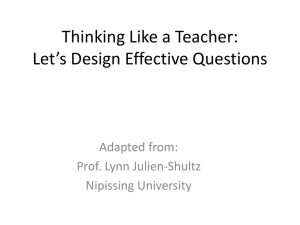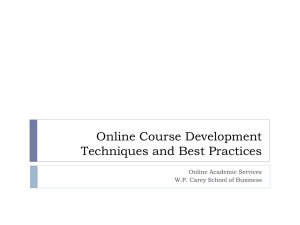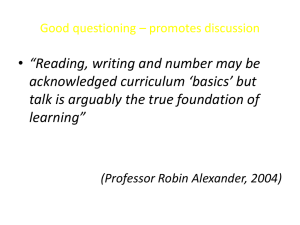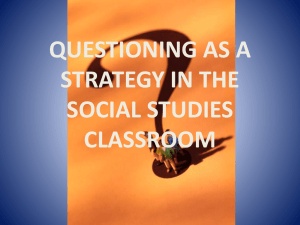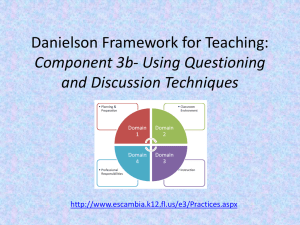The Art of Questioning - Sheboygan Area School District
advertisement
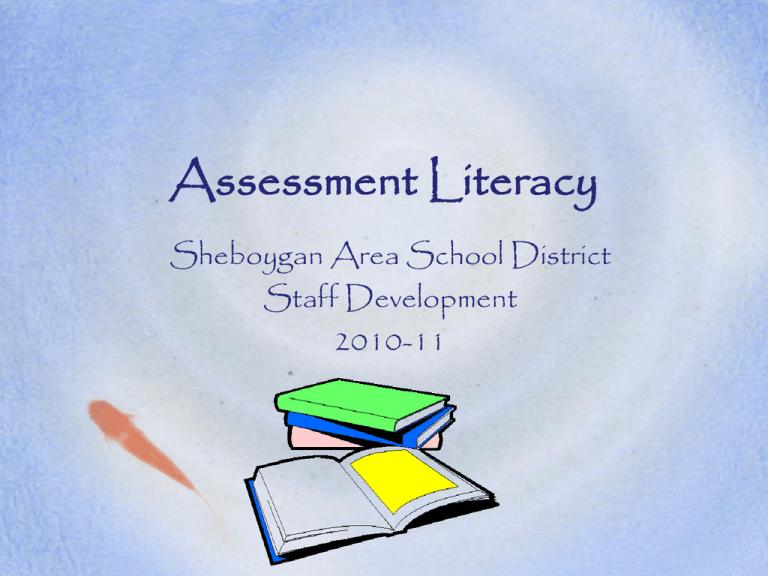
Assessment Literacy Sheboygan Area School District Staff Development 2010-11 Thought for the Day… A good teacher makes you think even when you don’t want to. Agenda for Tonight’s Inservice • Purpose of inservice: overview of assessments for and of learning – 10 minutes • Stiggins’ video presentation – 10 minutes • PowerPoint presentation and discussion – 45 minutes • Break – 15 minutes • ‘Jigsaw’ an article – 25 minutes • Assessment rubric – 15 minutes • Samples of quality assessments/discussion – 30 minutes • Your own assessment activity – 30 minutes Current practices in classrooms… • Many students are engaged only in lower-order thinking; i.e. they receive, or recite, or participate in routine practice. In no activities during the lesson do students go beyond simple reproduction of knowledge. • Or…many students are primarily engaged in routine lower-order thinking for a good share of the lesson. There is at least one significant question or activity in which some students perform some higher-order thinking. • Or,…almost all students, almost all of the time are engaged in higher-order thinking. Why is good assessment essential? To gather evidence of student learning that will inform instructional decisions in ways that maximize learning… Wisconsin’s Balanced Assessment System http://www.dpi.state.wi.us/oea/pdf/bal system.pdf What are assessments for and of learning? FOR LEARNING • • • • • • Question to ask: What do my students need to know and understand to be ready to show mastery of the standards? Assessments diagnose student needs Assessment is an ongoing process for student achievement Assessments help teachers and students watch things get better over time Used by students and teachers during the learning process Student motivation: success becomes its own reward OF LEARNING • • • • • • Question to ask: What have my students learned and to what degree of proficiency? Assessments measure student knowledge State or district standardized assessments are used to determine what has been learned Classroom assessments are used for report card grades or other high stakes grading Used by students and teachers after the learning process Motivation is a result of a high stakes situation The Balanced Assessment Model Formative Assessment Process: Assessment for learning • • • • • • Informal teacher questions Conversation with student Informal observation Rough drafts of written work Learning log ( in progress) Reflective journals (multiple drafts) • Mathematics problem-solving sets • Practice science experiment Summative Assessment Process: Assessment of Learning • • • • • • Formal oral interview Conference with student Formal observation Final copy of written work Final learning log entries Final journal entries • Mathematics final solution • Final science experiment The Balanced Assessment Model • • • • Formative Assessment Process: Assessment for learning Summative Assessment Process: Assessment of Learning Rehearsal of presentation Working portfolio Practice checklist of do-overs Practice rubrics (analytical) • • • • • Homework, quizzes • Benchmark/interim tests Final presentation Showcase portfolio Final checklist Final rubrics (analytical/holistic) • Teacher made tests • High stakes standardized tests Seven strategies of Assessment for learning Where am I going? 1. Provide students with a clear and understandable vision of the learning target 2. Use examples and models of strong and weak work Where am I now? 3. Offer regular descriptive feedback. 4. Teach students to selfassess and set goals How can I close the gap? 5. Design lessons to focus on one learning target at a time 6. Teach students focused revision 7. Engage students in selfreflection, and let them keep track of and share their learning. Remember… • Quality questioning is essential for quality lessons…. » and • Quality lessons demand quality assessments… • How can ‘questioning’ inform assessment? What can we use from what we already know that will help us build quality assessments for and of learning? Let’s use some of what we already know to help us in our discussion of assessment… Remember Bloom And his Taxonomy…?? • In 1956, Benjamin Bloom found that over 95 % of the test questions students encounter require them to think only at the lowest possible level...the recall of information. • Bloom identified six levels within the cognitive domain, from the simple recall or recognition of facts, as the lowest level, through increasingly more complex and abstract mental levels, to the highest order which is classified as evaluation. 1956-2001… Bloom’s original taxonomy… •Evaluation •Synthesis •Analysis •Application •Comprehension •Knowledge The ‘New’ Bloom’s TaxonomyA Worthwhile Revision In 1996 a revision was led by David Krathwohl, a cognitive psychologist who worked with Bloom on the original taxonomy. The revision was completed in 2001. • The use of verbs in the new taxonomy, rather than nouns, is critical since the verbs represent the cognitive processes that students use on or with the content so that learning occurs. • Bloom’s Taxonomy Original Terms New Terms •Evaluation •Creating •Synthesis •Evaluating •Analysis •Analyzing •Application •Applying •Comprehension •Understanding •Knowledge •Remembering BLOOM’S REVISED TAXONOMY Creating Generating new ideas, products, or ways of viewing things Designing, constructing, planning, producing, inventing. Evaluating Justifying a decision or course of action Checking, hypothesizing, critiquing, experimenting, judging Analyzing Breaking information into parts to explore understandings and relationships Comparing, organizing, deconstructing, interrogating, finding Applying Using information in another familiar situation Implementing, carrying out, using, executing Understanding Explaining ideas or concepts Interpreting, summarizing, paraphrasing, classifying, explaining Remembering Recalling information Recognizing, listing, describing, retrieving, naming, finding Cognitive Processes • Remembering • Understanding • • • • • • Recognizing Listing Naming Finding Recalling Retrieving • • • • • • Classifying Summarizing Inferring Comparing Explaining Interpreting Cognitive Processes • Applying • Analyzing • Evaluating • Creating • Executing/Using • Implementing • • • • Comparing Differentiating Organizing Attributing • • • • Checking Critiquing Generating Planning • Producing Questioning… If you want a wise answer, ask a reasonable question. Johann Wolfgang Von Goethe (1749-1832) German poet, novelist and dramatist. Assessment questions to check for Remembering (lowest level) • • • • • • • What happened after...? How many...? What is...? Who was it that...? Can you name ...? Find the definition of… Describe what happened after… • Who spoke to...? • Which is true or false...? (Pohl, Learning to Think, Thinking to Learn, p. 12 Remembering, cont’ • • • • • • • • • • • • • • • • • List Memorize Relate Show Locate Distinguish Give example Reproduce Quote Repeat Label Recall Know Group Read Write Outline • • • • • • • • • • • • Listen Group Choose Recite Review Quote Record Match Select Underline Cite Sort Recall or recognition of specific information Assessments include: • Quizzes • Label diagrams • Definitions • List facts • Facts: true/false • Workbook pages • Worksheets •Vocabulary quizzes • Reproductions Assessment questions to check for Understanding • Can you explain why…? • Can you write in your own words? • How would you explain…? • Can you write a brief outline...? • What do you think could have happened next...? • Who do you think...? • What was the main idea...? • Can you clarify…? • Can you illustrate…? • Does everyone act in the way that …….. does? (Pohl, Learning to Think, Thinking to Learn, p. 12 Understanding, cont. • Restate • Identify • Discuss • Retell • Research • Annotate • Translate • Give examples of • Paraphrase • Reorganize • • • • • • • • • Describe Report Recognize Review Observe Outline Account for Interpret Give main idea • Estimate • Define Understanding of given information Assessments include: • Recitation • Examples • Summaries • Quizzes • Collections • Lists • Explanations • Labels • Outlines Assessment questions to check for Applying • Do you know of another instance where…? • Can you group by characteristics such as…? • Which factors would you change if…? • What questions would you ask of…? • From the information given, can you develop a set of instructions about…? (Pohl, Learning to Think, Thinking to Learn, P 13) Applying, cont’ • Translate • Paint • Manipulate • • • • • • • • • • • • • Exhibit • Illustrate • Calculate • Interpret • Make • Practice • Apply • Operate • Interview Change Compute Sequence Show Solve Collect Demonstrate Dramatize Construct Use Adapt Draw Using strategies, concepts, principles and theories in new situations Assessments include: • Photographs • Presentations • Illustrations • Interviews • Simulations • Performances •Demonstrations • Diary entries • Journal entries Assessment questions to check for Analyzing • Which events could not have happened? • If. ..happened, what might the ending have been? • How is...similar to...? • What do you see as other possible outcomes? • Why did...changes occur? • Can you explain what must have happened when...? • What are some or the problems of...? • Can you distinguish between...? • What were some of the motives behind..? • What was the turning point? • What was the problem with...? (Pohl, Learning to Think, Thinking to Learn, p. 13) Analyzing cont’ • • • • • • • • • • • • • • • Distinguish Question Appraise Experiment Inspect Examine Probe Separate Inquire Arrange Investigate Sift Research Calculate Criticize • • • • • • • • • • • • • • • Compare Contrast Survey Detect Group Order Sequence Test Debate Analyze Diagram Relate Dissect Categorize Discriminate Breaking information down into its component elements Assessments include: • Graph • Survey • Spreadsheet • Database • Checklist • Mobile • Chart • Abstract • Outline • Report Assessment questions to check for Evaluating • Is there a better solution to...? • Judge the value of... What do you think about...? • Can you defend your position about...? • Do you think...is a good or bad thing? • How would you have handled...? • What changes to.. would you recommend? • Do you believe...? How would you feel if. ..? • How effective are. ..? • What are the consequences..? • What influence will....have on our lives? • What are the pros and cons of....? • Why is ....of value? • What are the alternatives? • Who will gain & who will loose? (Pohl, Learning to Think, Thinking to Learn, p. 14) Evaluating, cont’ • • • • • • • • • • • • • • • • Judge Rate Validate Predict Assess Score Revise Infer Determine Prioritize Tell why Compare Evaluate Defend Select Measure • • • • • • • • • • • • • • • Choose Judging the value of Conclude ideas, materials and Deduce methods by developing Debate and applying standards Justify and criteria. Recommend Discriminate Appraise Value Assessments include: Probe • Investigations • Debates Argue • Verdicts Decide • Panels Criticize •Persuasive • Reports Rank speeches • Evaluation Reject Assessment questions to check for Creating (highest level) • Can you design a...to...? • Can you see a possible solution to...? • If you had access to all resources, how would you deal with...? • Why don't you devise your own way to...? • What would happen if ...? • How many ways can you...? • Can you create new and unusual uses for...? • Can you develop a proposal which would...? (Pohl, Learning to Think, Thinking to Learn, p. 14) Creating, cont’ • • • • • • • • • • • • • • • Compose Assemble Organize Invent Compile Forecast Devise Propose Construct Plan Prepare Develop Originate Imagine Generate • Formulate • Improve Putting together ideas or elements to develop a original idea or engage in creative thinking. • Act • Predict • Produce • Blend • Set up Assessments include: • Devise • Film • Song •Projects • Newspaper • Plan • Advertisements •Media products • Paintings • Concoct • Compile Questions to think about when developing assessments… • Did I decide on the purpose(s) of my questions? • Did I choose important--rather than trivial--material to emphasize students' in-depth exploration of essential/key questions? • Did I differentiate my questions to ensure that all my students reached my targets? • Did I encourage discussion in my classroom by using openended questions? • Did I avoid "yes" and "no" questions? • Did I use "probe" questions to encourage students to elaborate and support assertions and claims? Questions to think about when developing assessments… • Did I ensure that students clearly understood my questions--and avoided a "guessing game?” • Did I avoid questions that "contain the answer"? • Did I anticipate students' responses to my questions, yet allow for divergent thinking and original responses? • Did I use purposeful strategies for helping students deal with incorrect responses? References • Bloom's(1956) Revised Taxonomy • Bloom’s Revised Taxonomy • • • • • • • • • http://rite.ed.qut.edu.au/oz-teachernet/training/bloom.html http://coe.sdsu.edu/eet/articles/bloomrev/index.htm http://www.fno.org/nov97/toolkit.html http://rite.ed.qut.edu.au/oz-teachernet/training/bloom.html http://serc.carleton.edu/introgeo/socratic/guiding.html http://serc.carleton.edu/introgeo/socratic/third.html http://changingminds.org/techniques/questioning/questioning.html http://serc.carleton.edu/introgeo/socratic/second.html http://images.google.com/images?hl=en&q=Questioning&um=1&ie=UTF8&sa=N&tab=wi Duncan, D. (2008). Blooms’ Taxonomy in relation to Social Studies. Powerpoint Presentation. Pohl, Michael. (2000). Learning to Think, Thinking to Learn: Models and Strategies to Develop a Classroom Culture of Thinking . Cheltenham, Vic.: Hawker Brownlow. References • Stiggins, R. et al. (2006), Classroom assessment for student learning: Doing it right. Portland, OR: Pearson Assessment Training Institute. • Tarlinton, D. (2003) Bloom’s Revised Taxonomy. bloomspres.ppt.Powerpoint Presentation. • Balanced assessment (2010). Solution Tree Press. Go.solutiontree.com/assessment
